Magnetism and Electromagnetism
1/21
There's no tags or description
Looks like no tags are added yet.
Name | Mastery | Learn | Test | Matching | Spaced |
|---|
No study sessions yet.
22 Terms
Poles of Magnets
North and South
Same poles repel
Opposite poles attract
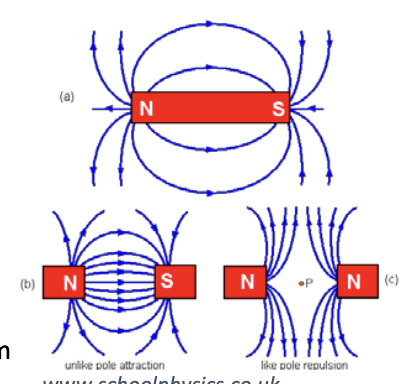
Permanent Magnets
Always magnetic, always have poles
Induced magnets
Materials that are ‘magnetic’ but do not have fixed poles
These can be made into temporary magnets by ‘stroking’ them with a permanent magnet
These align domains in material all the same direction, creating a temporary magnet
Iron, Nickel, Cobalt
Magnetic Fields
Field Lines: N → S
Strength decreases with distance from magnet
Direction always points to south pole and away from north
Use plotting compasses: small compasses which show the direction of magnetic field at a certain point
Earth’s Core
Magnetic
Creates a large magnetic field around the earth
We know this because a freely suspended magnetic compass will align itself with earth’s field lines and point North
It doesn’t point to the Geographic North pole — it is over North Canada
The compass is effectively a suspended bar magnet, with it’s own north pole lining up with Earth’s ‘North pole’
However this cannot be right as like poles repel
So Earth’s magnetic pole above canada is a magnetic south pole (and geographic south pole is close to magnetic north pole)
Current
Produces a magnetic field around the wire
Direction Dictated by the right hand grip rule
Plotting compasses on a piece of paper through which a wire is pierced shows this
Right hand grip rule
Thumb: direction of current
Fingers: Direction of field
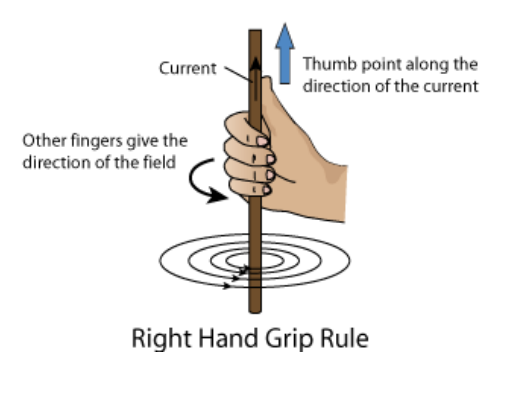
Solenoid
Shape of magnetic field similar to bar magnet
Enhances magnetic effect as coiling the wire causes the field to align and form a giant single field, rather than lots of them all perpendicular to direction of current
Iron core in centre: increases strength as it is easier for magnetic field lines to pass through than air
Factors that affect strength: Size of current, length, cross sectional area, number of turns (coils), using a soft iron core

The Motor Effect: Explanation
2 magnets will interact, feeling a magnetic force of attraction/repulsion
So a magnet and a wire will also exert a force, as the two magnetic fields (generated by the magnet and current in the wire) will also interact
Magnetic field around a wire is circular, but the magnetic field between two magnets is straight
When the two interact, the wire is pushed away from the field between the poles (at right angles to the wire direction and the field direction)
The Motor Effect: Visualised
Fixed permanent magnets have field lines along the x-axis, as the magnets sre at A and B and the field lines are shown
Wire is along y axis where current is moving up from C to D
Force felt on the wire is at right angles to both the direction of the current and magnetic field lines
Along the z axis
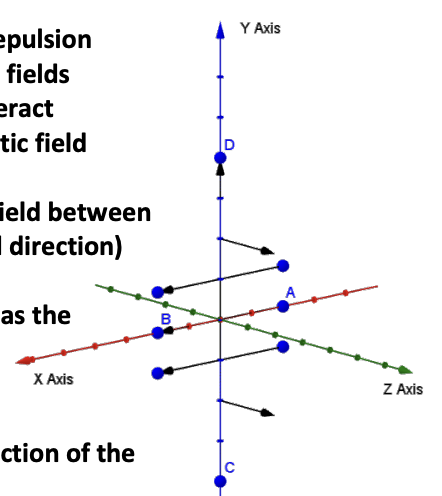
Fleming’s left hand rule
THUMB: Force
FIRST: Field
SECOND: Current
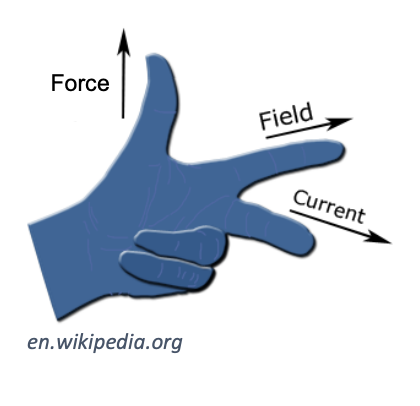
Force, Magnetic Flux Density, Current, Length
F = BIL
Force (N) = Magnetic Flux Density (Tesla) x Current (A) x Length (m)
Magnetic Flux Density
Measured in Tesla
Number of Flux Lines per metre squared
Electric Motors
Permanent Magnets lie in fixed positions
In between, a coil of current-carrying wire lies on an axis
Force on one sides moves that side up
Force on other side (current flows in opposite direction) moves down
This can be verified using Fleming’s left hand rule
Hence it rotates
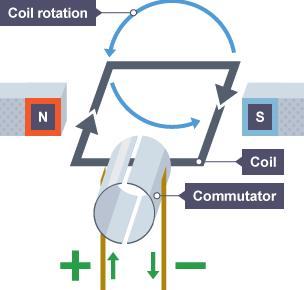
Electromagnetic Induction
When there is a relative movement between a conductor and a magnetic field, a potential difference is induced across the conductor
This happens if the magnetic field changes as well
A current flows if the conductor forms a complete circuit
This current will produce its own magnetic field, which oppose the change inducing it
Electric Generators (dynamos)
Same setup as a motor, with a coil of wire able to rotate between two permanent magnets
A turbine spins turning the coil of wire
The movement of the wire causes the wire to cut through the magnetic field
It experiences a change in magnetic field
This creates a potential difference
If the coil of wire is connected to a complete circuit, and AC will flow - this is a basic alternator
DC is produced if the ends (A and D in diagram) are connected to a split ring communicator
This reverses the current each half-rotation so current remains positive - this is called a dynamo
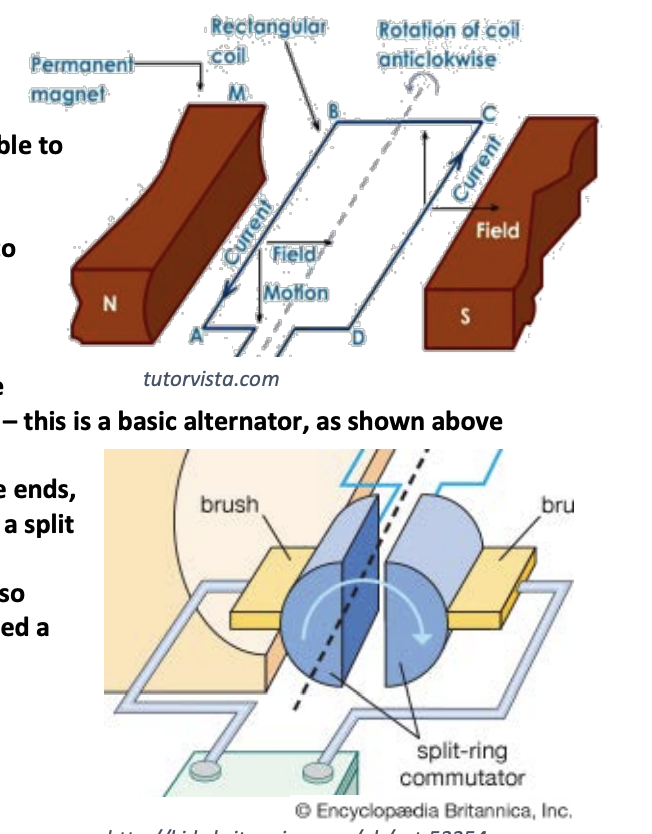
AC produced by Alternator
Alternating Current

DC produced by Dynamo
Direct Current
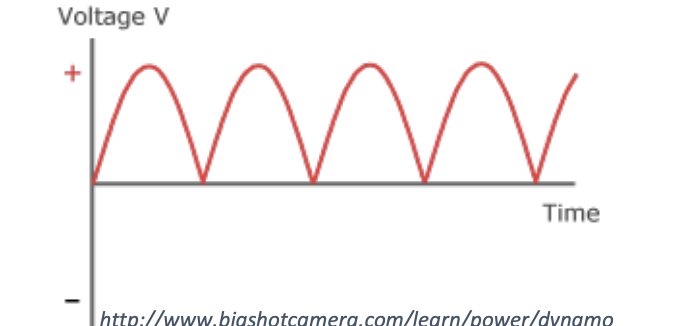
Transformers
AC in first coil creates a changing magnetic field
This changing magnetic field cuts through the secondary coil
This induces a current in the secondary coil
Which is also AC
If primary current was DC, magnetic field produced would be constant, not inducing anything on the secondary coil
More coils on secondary: step up transformer, as voltage will be increased, as changing field will cut through more of the seconday wire inducing a larger pd
Fewer coils on secondary: step down transformer, as smaller pd forms on secondary
number of coils on primary, secondary, pd equation
number of coils on primary / number of coils on secondary = pd of primary / pd of secondary
this only works with the current too if the transformer is 100% efficient. unless it states this, assume not and just use this to find voltage
Dynamic Microphones
Produce a current which is proportional to the sound signal
Fixed magnet is at the centre, and the coil of the wire around the magnet is free to move
Pressure variations in the sound waves cause the coil to move, and as it moves current is induced in the coil (because it cuts the magnetic field)
The current is then sent to a loudspeaker
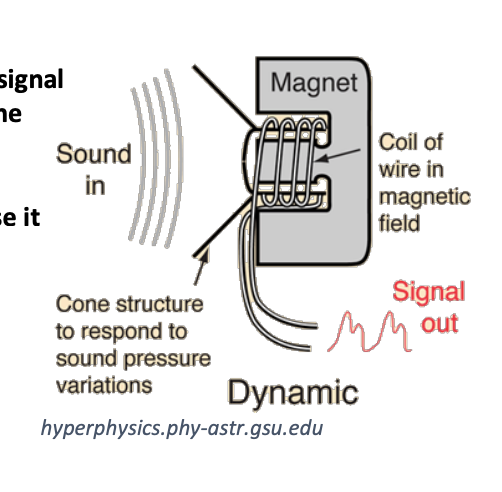
Loudspeakers
Set up identical to Dynamic Microphones, working in reverse
Current flows into coil
Magnetic field from magnet and from current interact, causing the coil to move
The cone therefore moves
Producing pressure variations, making sound